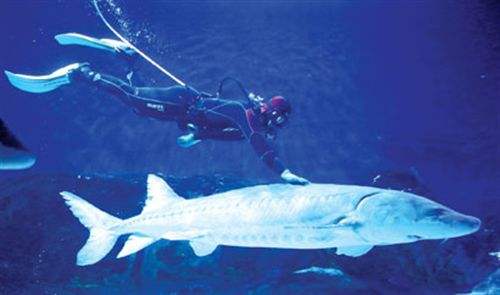The Chinese sturgeon is the largest and longest-lived freshwater fish. (After the extinction of the Chinese sturgeon)

The Chinese sturgeon is the oldest vertebrate on Earth and a descendant of the ancient stickleback, the common ancestor of fish, with a history of 140 million years. It lived in the same period as the dinosaurs. Due to a series of primitive characteristics, the Chinese sturgeon is a group between cartilaginous fish (sharks, etc.) and bony fish, and is also a more primitive group among bony fish. It has important academic value in the history of fish evolution. The Chinese sturgeon occupies an extremely important position in classification and is an important reference for studying fish evolution. It has important scientific value and inestimable ecological and social value in studying biological evolution, geology, landforms, sea invasion, sea retreat and other earth changes. However, due to various reasons, this rare animal is on the verge of extinction. Protecting and saving this rare and endangered "living fossil" has far-reaching significance for the development and rational development and utilization of wildlife resources and the maintenance of ecological balance. Some traces of biological evolution can be seen from it, so it is called a living fossil among aquatic organisms.
According to relevant documents in 1834, the model origin of the Chinese sturgeon is China. Although it is not a Chinese specialty, it is famous because its model origin is in China. Later, some people speculated that it was Guangzhou based on the history of China at that time and the work of later generations. This species has been recorded in the Yellow River, Yangtze River, Li River, Ming River and Qingtang River in southwestern Korea and western Kyushu, Japan, but has disappeared from all these areas except the middle and lower reaches of the Yangtze River.
In order to protect this species, the relevant departments have conducted research on breeding, transplanting and releasing for many years. It can now be transplanted to ponds and reservoirs, grows well, and has become a promising freshwater aquaculture fish. The release results are also impressive. By 1992, more than 1 million tails had been released, which gradually increased the resource volume.
Listed in the "Red List of Endangered Species of the World Conservation Union" (IUCN) 2009 ver 3.1-Critically Endangered (CR).
Listed in Appendix I, Appendix II and Appendix III of the Convention on International Trade in Endangered Species of Wild Fauna and Flora (CITES) 2019 Edition.
Listed in China's "National List of Key Protected Wildlife" (February 5, 2021) Level I.
Protect wildlife and eliminate game.
Maintaining ecological balance is everyone's responsibility!